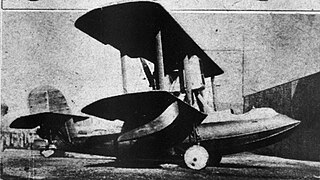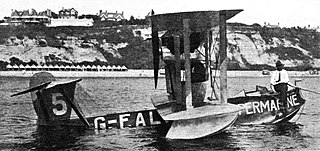
The Supermarine Stranraer is a flying boat designed and built by the British Supermarine Aviation Works company at Woolston, Southampton. It was developed during the 1930s on behalf of its principal operator, the Royal Air Force (RAF). It was the RAF's last and fastest biplane flying boat.
The AD Navyplane was designed by the British Admiralty's Air Department as a reconnaissance aircraft for use during World War I. Performance of the prototype was so disappointing that plans to produce it were cancelled almost immediately.

The Vickers Viking was a British single-engine amphibious aircraft designed for military use shortly after World War I. Later versions of the aircraft were known as the Vickers Vulture and Vickers Vanellus.

The Supermarine Sea Otter was an amphibious aircraft designed and built by the British aircraft manufacturer Supermarine. It was the final biplane flying boat to be designed by the company, and the last biplane to enter service with both the Royal Navy and the Royal Air Force (RAF).

The Supermarine Southampton was a flying boat of the interwar period designed and produced by the British aircraft manufacturer Supermarine. It was one of the most successful flying boats of the era.

The Supermarine Seagull was a flying boat produced by the British aircraft manufacturer Supermarine. It was developed by Supermarine's chief designer R.J. Mitchell from the experimental Supermarine Seal II.

The Norman Thompson N.T.4 was a twin-engined British flying boat of the First World War. Although less well known than similar Curtiss and Felixstowe flying boats, 50 were ordered for Britain's Royal Naval Air Service.

The Supermarine Swan was a 1920s British commercial biplane flying boat designed by R.J. Mitchell. A single machine was built by Supermarine at their works at Woolston, Southampton. The world's first twin-engine amphibian aircraft, it was the precursor to the Supermarine Southampton.

The Supermarine Sea Lion II was a British racing flying boat built by the Supermarine Aviation Works. Designed by Reginald Mitchell, the Sea Lion II was a modification of Supermarine's Sea King II. It was powered by a 450 hp (340 kW) Napier Lion engine.

The Supermarine Sea Lion I was a British racing flying boat designed and built by Supermarine for the Schneider Trophy contest at Bournemouth, England, in September 1919. It was based on a version of the Supermarine Baby, the first single-seat flying boat fighter aircraft to be designed and built in the United Kingdom, that first flew in February 1918.

The Supermarine Sea Eagle was a British, passenger–carrying, amphibious flying boat. It was designed and built by the Supermarine Aviation Works for its subsidiary, the British Marine Air Navigation Co Ltd, to be used on their cross-channel route between Southampton, the Channel Islands and France.

The Supermarine Sea King was a British single-seat amphibious biplane fighter designed by Supermarine in 1919. Developed from the Supermarine Baby and the Supermarine Sea Lion I, the Sea King was a single seater biplane powered by a pusher 160 horsepower (120 kW) Beardmore engine. It first flew in early 1920 and was exhibited by Supermarine at the 1920 Olympia Show in London. The company released drawings of the aircraft's design prior to the show; what it exhibited was probably a modified Supermarine Baby.

The Supermarine Baby was a First World War fighter aircraft that was the earliest example of a single-seat flying boat fighter to be built in the United Kingdom. It was designed by Supermarine to meet a 1917 Navy Board specification which stipulated the aircraft have a speed of 95 knots, a ceiling of 20,000 feet (6,100 m), and be capable of being launched from ships at sea. When it first flew in February 1918 it was one of the smallest and fastest flying boats then in existence.

The Supermarine Commercial Amphibian was a passenger-carrying flying boat. The first aircraft to be designed by Supermarine's Reginald Mitchell, it was built at the company's works at Woolston, Southampton, for an Air Ministry competition that took place during September 1920. Based on the Supermarine Channel, the Amphibian was a biplane flying boat with a single engine, a wooden hull, unequal wingspans and a 350 horsepower (260 kW) Rolls-Royce Eagle engine. The pilot sat in an open cockpit behind two passengers.

The Supermarine Nanok was a British three-engined biplane flying boat built by Supermarine. Built to meet a Royal Danish Navy requirement, the single prototype was rebuilt as a private air yacht and renamed the Supermarine Solent.

The Supermarine Seal II was a British flying boat developed by Supermarine after it secured a British Air Ministry order for a prototype three-seater fleet spotter amphibian. The prototype, which had to be capable of landing on Royal Air Force (RAF) aircraft carriers, was designed by Supermarine's R.J. Mitchell, who incorporated suggestions made after the Supermarine Commercial Amphibian achieved second place after it was entered for an Air Ministry competition in 1920.

The Norman Thompson N.T.2B was a British single-engined flying boat trainer of the First World War. A single-engined biplane, the N.T.2B was adopted as a standard flying boat trainer by the Royal Naval Air Service, training pilots for larger patrol flying boats such as the Felixstowe F.2.

The Supermarine Channel was a modified version of the AD Flying Boat, purchased by Supermarine from the British Air Ministry and modified for the civil market with the intention of beginning regular air flights across the English Channel. The aircraft were given airworthiness certificates in July 1919. The Mark I version, later called the Channel I, was powered with a 160 horsepower (120 kW) Beardmore engine; a variant designated as Channel II was fitted with a 240 horsepower (180 kW) Armstrong Siddeley Puma engine. Designed by Supermarine to accommodate up to four passengers, the company produced a series of interchangeable interiors that could be used at short notice, which enabled the Channel to be used as a fighter or for training purposes.

The Hiro H2H, or "Navy Type 89 Flying boat", was a Japanese patrol flying boat of the 1930s. Designed and built by the Hiro Naval Arsenal, it was a twin-engined biplane that was operated by the Imperial Japanese Navy.

The Sage Type 4 was a prototype British floatplane of the First World War. It was a designed as a two-seat reconnaissance aircraft for the Royal Naval Air Service, but was chosen for service as a floatplane trainer, although the end of the war resulted in production being cancelled.




















